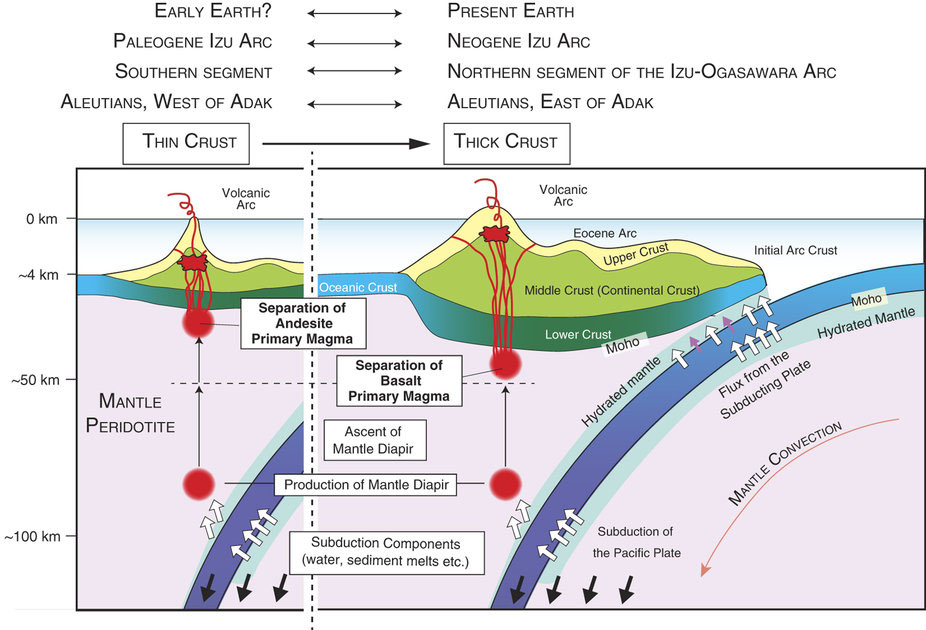大陸の出現:新しい仮説
Advent of Continents: A New Hypothesis
2016年9月27日 Scientific Reports 6 : 33517 doi: 10.1038/srep33517

本論文では、これまで予想されていなかった単純明快な関係を提示する。それは、海洋島弧である伊豆‐小笠原(ボニン)弧およびアリューシャン弧の、火山の下の地殻の厚さと噴出するマグマとの関係である。伊豆‐小笠原弧の南部とアリューシャン弧の西部(アダック島西部)に沿った火山の下には薄い(10-20km)地殻が存在する。これとは対照的に、伊豆‐小笠原弧北部とアリューシャン弧東部に沿った火山の下には35kmの厚さの地殻が存在する。興味深いことに、前者(薄い地殻)の火山の噴出物は安山岩マグマが多いが、後者(厚い地殻)の火山からは大部分は玄武岩溶岩が噴出している。(この関係に基づき)本論文で次の仮説を提示する。マントル・ダイアピル(マグマの源であるマントル)はマントルウェッジ内を上昇するが、その定置位置はその上にある地殻の厚さにより制御されており、地殻の直下で停止する(つまり、地殻直下のマントルが融解する)。地殻が薄いところでは、マントルウェッジ内の比較的低圧で(マントルの)融解が生じて(マントルで直接)安山岩マグマを生成する。地殻が厚いところでは、(マントルの)融解する圧力はより高く、(必然的に)玄武岩マグマのみが生成される。この仮説は以下の二点を意味している。(1)大陸地殻は、安山岩の平均組成を持つが、その成長速度は、地球上で沈み込みが始まった直後が最大となる。なぜなら、そのときは、地球上のほとんどの地殻が薄かったからである;(2)(地殻の厚い)大陸地殻で噴出する安山岩マグマの大部分は、もともとは(地殻の薄い)海洋島弧で生成された「初生」安山岩が、玄武岩マグマによって再融解して噴出した(リサイクルした)可能性がある。
Corresponding Author
The straightforward but unexpected relationship presented here relates crustal thickness to magma type in the Izu-Ogasawara (Bonin) and Aleutian oceanic arcs. Volcanoes along the southern segment of the Izu-Ogasawara arc and the western Aleutian arc (west of Adak) are underlain by thin crust (10–20 km). In contrast those along the northern segment of the Izu-Ogasawara arc and eastern Aleutian arc are underlain by crust ~35 km thick. Interestingly, andesite magmas dominate eruptive products from the former volcanoes and mostly basaltic lavas erupt from the latter. According to the hypothesis presented here, rising mantle diapirs stall near the base of the oceanic crust at depths controlled by the thickness of the overlying crust. Where the crust is thin, melting occurs at relatively low pressures in the mantle wedge producing andesitic magmas. Where the crust is thick, melting pressures are higher and only basaltic magmas tend to be produced. The implications of this hypothesis are: (1) the rate of continental crust accumulation, which is andesitic in composition, would have been greatest soon after subduction initiated on Earth, when most crust was thin; and (2) most andesite magmas erupted on continental crust could be recycled from “primary” andesite originally produced in oceanic arcs.

